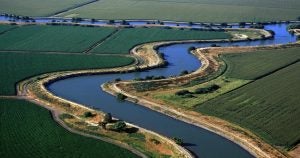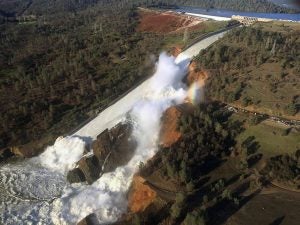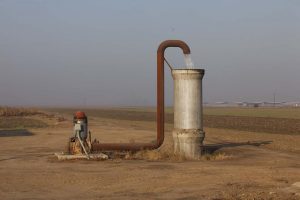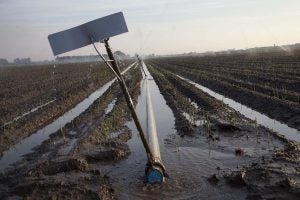
The hidden opportunity for water storage in California

California’s historic winter ended the drought in many parts of the state and piled up record levels of snowpack in the Sierra Nevada Mountains. With so much precipitation, surface water infrastructure – our network of dams, reservoirs and levees – has been called into action like never before, and in some cases has struggled to handle the influx of flows.
With spring temperatures on the rise, snowmelt and runoff have accelerated, adding another wave of stress to the system. And with snowpack still at 192% of average, there is even more runoff on the way.
So where will all this water go?
With many reservoirs near capacity already, water managers have had to allow spring snowmelt to flow out through the Sacramento-San Joaquin Delta and into the ocean. This is inevitable given the sheer amount of water in the system this year, and in fact, these occasional high flows provide multiple benefits to ecosystems and coastal communities.
But wouldn’t it be nice if water managers could keep a bit more of this water in the system – not just to ensure delivery to agricultural and urban water contractors, but to hedge against future dry years and prolonged droughts?
Many are calling for increased surface water storage by building new dams and increasing reservoir capacity across the state. And while some of these projects make sense, others will likely prove too costly for the marginal benefits they provide.
[Tweet “A hidden opportunity for water storage in California lies beneath our feet, via @GrowingReturns.https://edf.org/8Jx”]
The answer is beneath our feet
 One underused opportunity for storage is putting more water into groundwater aquifers. During the drought these aquifers were significantly depleted across the state, and even before the drought, many of our groundwater basins were overpumped. Some estimates show that we’ve lost more than 150 million acre-feet of groundwater in Central Valley aquifers over the past century. This has had devastating effects, such as water supply contamination and land subsidence.
One underused opportunity for storage is putting more water into groundwater aquifers. During the drought these aquifers were significantly depleted across the state, and even before the drought, many of our groundwater basins were overpumped. Some estimates show that we’ve lost more than 150 million acre-feet of groundwater in Central Valley aquifers over the past century. This has had devastating effects, such as water supply contamination and land subsidence.
The silver lining to this depletion? There is now plenty of room to store water in these aquifers. Essentially vast underground reservoirs that can accommodate excess water and ease the pressure on our surface water reservoirs during wet years like this one. And, importantly, water stored in underground aquifers could be used to supplement supplies during periods of drought.
The groundwater storage potential is massive – much more than the approximate 42 million acre-feet of total surface storage capacity.
Planning for the future
While groundwater recharge occurred in many basins across the state through natural processes, we unfortunately missed opportunities to take full advantage of underground storage this year.
Recharging aquifers basically means spreading water out on land that has porous soils and letting it soak in. During wet years, our facilities and rules are designed to send water downstream to prevent flooding rather than spreading it out so that it can seep back into our aquifers. So to take full advantage of wet years like this one, we need to look at our water system and policies in new ways.
 Luckily we are moving in the right direction and recharging our aquifers at a higher rate. Local water districts and even individual farmers have demonstrated a growing interest in groundwater recharge. Some have started to implement projects and re-purpose land to create more recharge basins.
Luckily we are moving in the right direction and recharging our aquifers at a higher rate. Local water districts and even individual farmers have demonstrated a growing interest in groundwater recharge. Some have started to implement projects and re-purpose land to create more recharge basins.
When we talk about the need for water storage in California, we must take full inventory of the tremendous opportunity of our underground natural storage infrastructure. If we focus on this now, we’ll be able to take advantage of the next wet winter.
And, importantly, we’ll be better prepared for the next inevitable drought when it comes – and it will come.
Related:
What it’s going to take to fund California’s water infrastructure >>
Why one wet winter won’t solve California’s water problems >>
What the Oroville Dam crisis tells us about natural infrastructure >>












4 Comments
Although brief, this was a very well-written exhortation for folks to take advantage of an underused resource. I appreciate that it was practical, rather than preachy–makes EDF stand out as a potential ally for resource managers.
This is an excellent idea that has been known to water supply and treatment professionals for quite some time. I’m glad that the article underscores the importance of subsurface storage, where evaporative losses are also not a concern, as they are for large reservoirs such as Lake Mead. However, the author fails to note that the referenced land subsidence compresses the aquifers lying beneath, resulting in the permanent loss of some storage capacity.
Sadly the aquifers are so depleted and space collapsed that there may be no space for water to go. Clean, gentle repumping might be necessary not just settlement basins.
The concept is simple and easy to like, but the devil’s in the details. Large scale recharge of short-duration high river flows requires lots of infrastructure; diversion dams, high capacity conveyance, distribution, and lots of land with a suitable deep soil profile. These lands lie adjacent to the foothill rim. As you get to the center of the valley, soils get tighter, and recharge isn’t effective. And much of this infrastructure would only operate a few months each decade, so it’s very hard to capitalize the cost, much less fund and staff the O&M. Recharge systems would sit idle for entire election cycles. This is a problem.
Small, incremental, localized recharge projects yield very little benefit to the groundwater budget. Fresno probably has the best application of localized recharge, but their system was implemented concurrent with development. It would be nearly impossible to do this after the fact. I’d encourage readers to consider the grizzly details before fully embracing this concept.